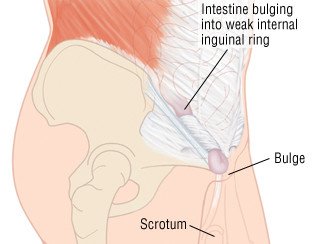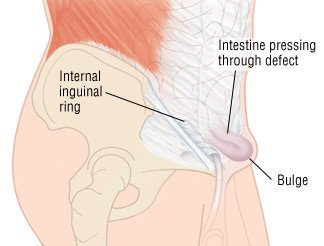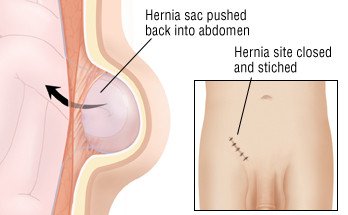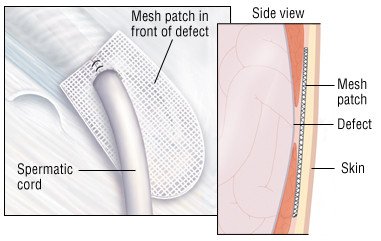Inguinal Hernia
Medically reviewed by Drugs.com. Last updated on Oct 11, 2023.
What is an Inguinal Hernia?

When part of an organ protrudes through an abnormal opening or in an abnormal way, this is called a hernia. A groin (inguinal) hernia occurs when part of the intestine bulges through a weak spot in the abdominal wall at the inguinal canal. The inguinal canal is a passageway through the abdominal wall near the groin. Inguinal hernias are up to 10 times more common in men than in women. About one in four men develop a hernia at some point in life.
There are two types of inguinal hernias:
- Indirect inguinal hernia — This occurs when the internal opening of the inguinal canal, which usually closes around the time of birth, remains open. This allows a portion of the intestine to slip through the inguinal canal. These hernias often are diagnosed within the first year of life, but may not show up until adulthood. This condition affects between 1% and 5% of normal newborns and up to 10% of premature infants.
|
|
- Direct inguinal hernia — This occurs when a portion of the intestine protrudes through a weakness in the abdominal muscles along the wall of the inguinal canal. These are common in adults, but rarely occur in children.
|
|
In adults, direct and indirect inguinal hernias look and feel about the same. They can occur on one or both sides of the groin. Your doctor may not know which type of hernia you have until surgery is performed. However, both types of hernias are treated in a similar manner.
A type of hernia called a femoral hernia can appear similar to an inguinal hernia. Femoral hernias are much more common in women than in men. They may cause a lump that appears just below the groin and extends into the upper portion of the thigh. In a femoral hernia, a portion of the intestine protrudes through the passage that is normally used by large blood vessels (the femoral artery and vein) when they pass between the abdomen and the leg. Femoral hernias are most common in older, overweight women.
Symptoms
At first, an inguinal hernia either may not cause any symptoms or may cause only a feeling of heaviness or pressure in the groin. Symptoms are most likely to appear after standing for long periods, or when you engage in activities that increase pressure inside the abdomen, such as heavy lifting, persistent coughing or straining while urinating or moving the bowels.
As the hernia grows, it eventually causes an abnormal bulge under the skin near the groin. This bulge may become increasingly more uncomfortable or tender to the touch. As the hernia increases in size, a portion of herniated intestine may become trapped and unable to slide back into the abdomen. If this happens, there is a danger that the trapped intestine may twist and die because its blood supply is cut off. This causes severe pain and requires immediate treatment.
Diagnosis
Your doctor will review your symptoms and medical history. He or she will ask you when you first noticed the lump in your groin, whether it has become larger, and whether it hurts.
Doctors can diagnose most inguinal hernias by examining the area. Your doctor will look for an abnormal protrusion near your groin and will feel the area to check for a mass. Often, the protruding hernia can be pushed back temporarily into the abdomen with careful pressure. Your doctor may ask you to cough or strain, which may make the hernia easier to feel or see.
In some cases, your doctor may need to confirm the diagnosis with an ultrasound or computed tomography (CT) scan. In these procedures, painless sound waves or X-rays can distinguish a hernia from other causes of a mass in the groin area, such as an enlarged lymph node (swollen gland).
Expected Duration
An inguinal hernia will not heal on its own. It is likely to become larger and cause increased discomfort until it is repaired. Hernias that are not repaired can cause bowel obstruction or strangulation, which is when part of the intestine dies because its blood supply is cut off.
Prevention
Indirect hernias in children cannot be prevented. To reduce the risk of inguinal hernia as an adult, you can:
- Maintain a normal body weight.
- Exercise regularly to strengthen abdominal muscles.
- Avoid straining while defecating or urinating.
- Avoid lifting heavy objects.
Treatment
Not all hernias need to be treated. However, most hernias that cause symptoms or that become even a little larger should be repaired by a surgeon. While awaiting surgery, some people wear a device called a truss, which puts pressure on the hernia and may help relieve discomfort temporarily. Except in very rare cases, the truss should not be considered a long term solution.
There are two basic types of hernia repair: open surgery or laparoscopic surgery. Both usually are done on an outpatient basis and take about one hour to complete.
- Open surgery — Most inguinal hernias are repaired by open surgery with the patient under general or local anesthesia. After the surgeon makes an incision in the groin, he or she pushes the herniated tissue back into place and repairs the hernia opening with stitches. In many cases, a small piece of synthetic mesh material is used to reinforce the area to prevent another hernia.
|
|
|
|
- Laparoscopic surgery — In laparoscopic hernia repair, a surgeon makes three small incisions in the abdominal wall and then inflates the abdomen with a harmless gas. The surgeon then inserts a laparoscope through the incisions. A laparoscope is a tube-like instrument with a small video camera and surgical instruments. While viewing the internal scene on a monitor, the surgeon pushes the herniated intestine back into place and repairs the hernia opening with surgical staples. Although this surgery seems attractive to many people, the long-term success rate is lower compared to open surgery. Laparoscopic surgery often causes less discomfort, and lets the person return to activities more quickly. If you are interested in laparoscopic surgery, discuss the advantages and disadvantages with your doctor.
When To Call a Professional
Contact your doctor if you develop a lump, tenderness or a persistent feeling of heaviness in your groin area. In babies and young children, call your doctor promptly if you notice a lump in the child's groin or scrotum.
Prognosis
Hernia surgery is very safe and usually quite effective. Depending on the location and size of the hernia and what technique is used, up to 10% of hernias may develop again at some point in the future.
After open surgery, the person can usually resume normal activities within one to two weeks. For laparoscopic surgery, full recovery generally takes one week or less. After any hernia surgery, the person should avoid heavy lifting for six to eight weeks (or as long as the doctor directs) to allow muscle and tissues to heal completely.
Additional Info
National Digestive Diseases Information Clearinghouse (NDDIC)
https://www.niddk.nih.gov/health-information/digestive-diseases
American College of Surgeons (ACS)
http://www.facs.org/
Learn more about Inguinal Hernia
Treatment options
Care guides
Further information
Always consult your healthcare provider to ensure the information displayed on this page applies to your personal circumstances.




